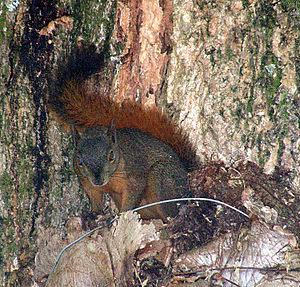North Amazon red squirrel
| North Amazon red squirrel | ||||||||||||
|---|---|---|---|---|---|---|---|---|---|---|---|---|

North Amazon red squirrel ( Sciurus igniventris ) |
||||||||||||
| Systematics | ||||||||||||
|
||||||||||||
| Scientific name | ||||||||||||
| Sciurus igniventris | ||||||||||||
| Wagner , 1842 |
The North Amazonian red squirrel ( Sciurus igniventris ) is a species of squirrel from the genus of squirrels ( Sciurus ). It occurs in northern South America.
features
The North Amazon red squirrel reaches a head-trunk length of about 24.0 to 29.5 centimeters, plus a tail that is about 24.0 to 30.5 centimeters long. The weight is 500 to 900 grams. The back color of the animals is dark chestnut brown to red or rust red to yellowish orange with black coloring. The ears are only finely haired and clearly rise above the forehead, which is colored black. Spots behind the ears (post-auricular spots) are absent or are only very indistinctly light yellow. The feet are bright orange or red without black parts. The color of the ventral side is sharply demarcated from the back color and is sometimes delimited by a dark line on the flanks; it is pale orange, red or whitish. The tail is bushy and black at the base, orange to rust-red towards the end. Occasionally melanism occurs in animals.
distribution
The North Amazon red squirrel is found in northern South America in Colombia , Venezuela , Ecuador , Brazil and Peru .
Way of life
The North Amazon red squirrel lives in the area of the lowland rainforests on the Amazon , it occurs in primary forests and also in disturbed forest areas. The animals are diurnal and feed primarily herbivore and especially on the larger tree seeds, whose thick and hard seed coats they can open due to their strong jaws and teeth. Their presence can be determined very well based on the very loud gnawing noises. They also eat other tree and palm fruits and nuts and, rarely, insects. The squirrel often looks for its food in the deciduous areas of the trees as well as on the ground and in the lower shrub and tree areas. The animals seek their food alone and only meet other individuals in the area of richer food resources. They are quickly startled and flee when there is danger through the undergrowth on the ground. Calls are seldom; in case of danger they produce a short series of low-frequency "chucks".
Systematics
The North Amazon red squirrel is classified as an independent species within the genus of the squirrel ( Sciurus ), which consists of almost 30 species. The first scientific description comes from Johann Andreas Wagner from 1842, who described the species on the basis of individuals from Brazil from the Amazon region north of the Rio Negro . Together with the South Amazon red squirrel ( Sciurus spadiceus ) it is sometimes assigned to the subgenus Urosciurus .
Within the species, two subspecies are distinguished with the nominate form :
- Sciurus igniventris igniventris : nominate form; lives in the eastern part of the range in Venezuela, Brazil and Peru. The subspecies has an ocher-reddish back color and a rust-red belly.
- Sciurus igniventris cocalis : lives in the western part of the range in Colombia, Ecuador and northern Peru. The shape has a dark blackish back band from head to tail, the belly is pale ocher to sand colored.
Status, threat and protection
The North Amazon red squirrel is listed as Least Concern by the International Union for Conservation of Nature and Natural Resources (IUCN). This is justified with the large distribution area, but a reassessment is recommended due to the increasing loss of habitat and the strong fragmentation.
In parts of the range, such as Limoncocha , Ecuador and the region around Iquitos in Peru, the species is hunted as a source of meat. In some regions, the animals are also popular pets and are caught for the pet trade.
supporting documents
- ↑ a b c d e f g Richard W. Thorington Jr. , John L. Koprowski, Michael A. Steele: Squirrels of the World. Johns Hopkins University Press, Baltimore MD 2012, ISBN 978-1-4214-0469-1 , pp. 57-58 .
- ↑ a b c Sciurus igniventris in the IUCN Red List of Threatened Species 2015.3. Posted by: G. Amori, J. Koprowski, L. Roth, 2008. Retrieved November 22, 2015.
- ↑ a b c d Sciurus igniventris In: Don E. Wilson , DeeAnn M. Reeder (Ed.): Mammal Species of the World. A taxonomic and geographic Reference. 2 volumes. 3. Edition. Johns Hopkins University Press, Baltimore MD 2005, ISBN 0-8018-8221-4 .
literature
- Richard W. Thorington Jr. , John L. Koprowski, Michael A. Steele: Squirrels of the World. Johns Hopkins University Press, Baltimore MD 2012, ISBN 978-1-4214-0469-1 , pp. 57-58 .
Web links
- Sciurus igniventris inthe IUCN Red List of Threatened Species 2015.3. Posted by: G. Amori, J. Koprowski, L. Roth, 2008. Retrieved November 22, 2015.